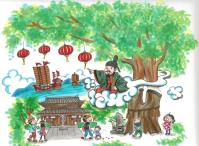Hakata Culture vol.66
Xie Guoming, a pioneer in creating friendly Japan-China relations

A small group of camphor trees stands on a corner along the small Dekimachi-dori near the Hakata Station. That is said to be the location of the grave of Xie Guoming, who promoted trade between Hakata and China in the 13th century. One camphor tree was planted next to his grave after burial, but with time the trees grew to envelop and hide the gravestone. Now the original tree has aged and only the large roots remain. The people of the community affectionately refer to it as Okusu-sama.
Xie Guoming was born in Lin’an, Hongzhou. After moving to Hakata, he became wealthy through trade with Song Dynasty China. He also made a great contribution through cultural exchange by bringing to Hakata many elements of Chinese culture, including Zen Buddhism. Joten-ji, one of the most well-known of Hakata’s Buddhist temples, was built by Xie using his personal funds.
One New Year’s Eve, many people in Hakata were suffering from starvation and illness. To help the poor, Xie brought his own supplies of soba to the temple grounds and served it. That’s why the custom of eating soba on New Year’s Eve is known as Un-soba (Luck soba), rather than Toshikoshi soba as it is everywhere else. After his death at the age of 88 in 1280, he was buried at a site east of where the temple was located at the time.
There was an international market in Hakata in those days. The most prominent of the many foreigners who frequented the market was Xie Guoming. He later became a naturalized Japanese citizen and took the name Shataro Kuniaki. For more than 700 years, the Okusu-sama Sentomyo festival has been held every year on August 21 in his honor. A second generation of camphor trees was planted next to the original withered tree, where they thrive today.
日中友好の先駆者、謝国明
博多駅前の出来町通りという小さな通り沿いに、楠が茂る一角があります。ここは13世紀に博多と中国の交易で活躍した謝国明の墓と伝えられています。埋葬後、墓の横に1本の楠が植えられたのですが、時とともに楠が墓石を包み込むように生長し、やがて墓はすっかり見えなくなってしまいました。今では楠も枯れて大きな根元を残すだけとなっていますが、地域の人々には「大楠様」と呼ばれて親しまれています。
謝国明は宋の臨安(杭州)出身で、博多に住んで日宋貿易で大きな財を築きました。また禅宗をはじめとした中国の文化を博多に紹介し、文化交流にも大きな貢献をしています。今では博多の代表的な寺院として知られる承天寺も、謝国明が私財をなげうって創建したものです。
ある年の大晦日、博多の町では飢饉や悪疫で多くの庶民が苦しんでいました。謝国明は貧しい人々を助けるため、蓄えていたそば粉などを持ち出して承天寺の境内でそばを振る舞ったそうです。この故事にならい、博多では「年越しそば」と言わずに「運そば」と呼ぶようになりました。弘安3年(1280年)に88歳で没したと伝えられる謝国明は、当時の承天寺の東のはずれに埋葬されました。
当時の博多は多くの外国人が行き来する国際都市でした。謝国明はその代表的な人物です。後に謝国明は日本に帰化し、謝太郎国明(しゃたろうくにあき)と名乗りました。毎年8月21日には謝国明を偲び、「大楠様千灯明祭」が行われています。700年以上も地域で受け継がれてきた行事です。枯れてしまった楠の隣には二代目の楠が植えられ、今では青々とした葉を茂らせています。

